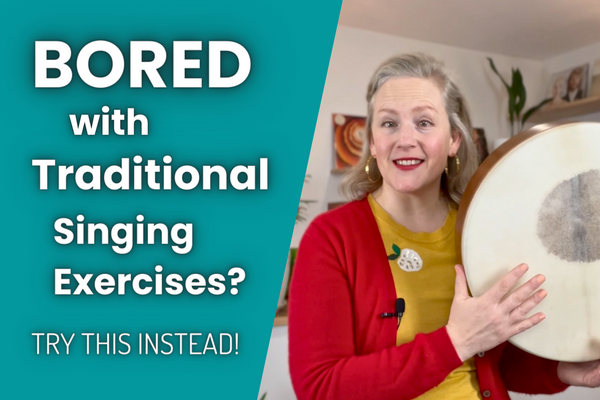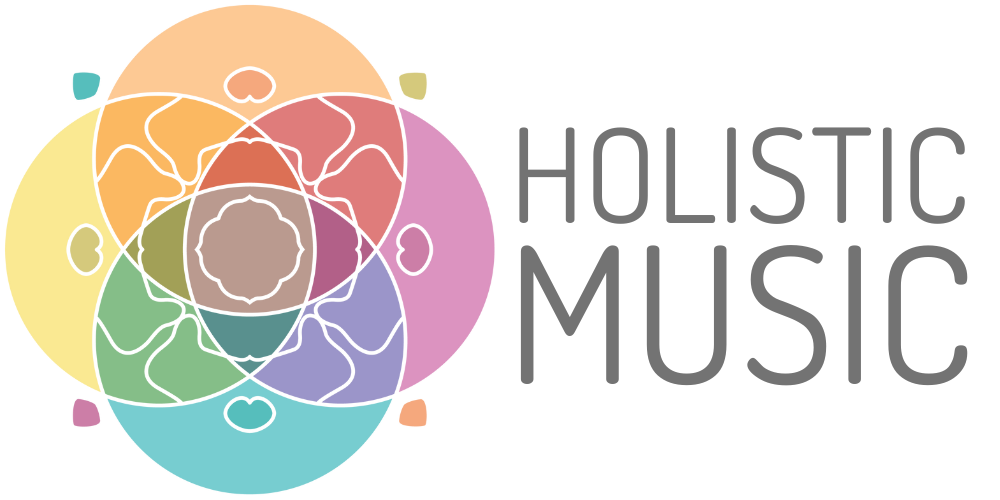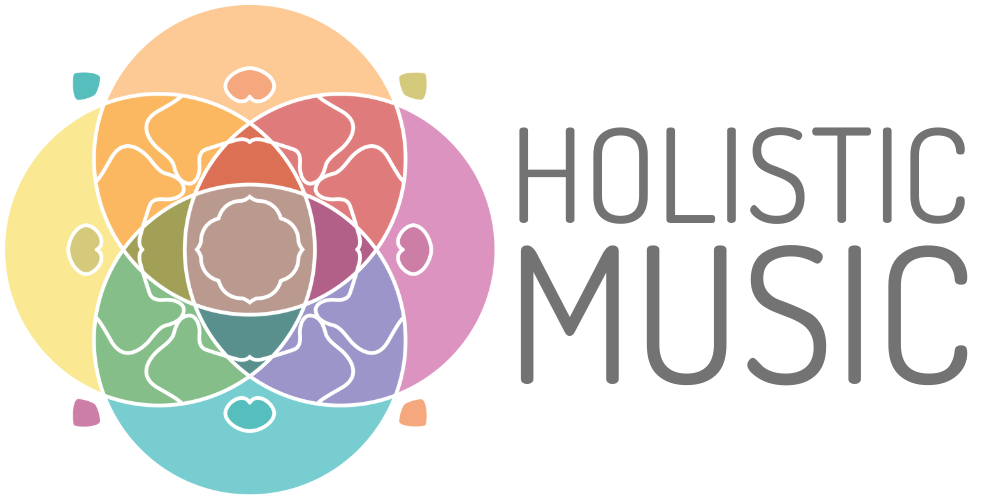
Bored With Traditional Singing Exercises?
Try a new way of learning and practicing singing!
If you’ve had singing lessons before and gotten to that point where boredom, and lack of motivation sets in, I hear you…. This happened for me too!
The traditional ways of learning to sing can certainly be effective in lots of ways - but they leave out really important pieces of our deeper inspiration and yearning to sing.
The good news is, this isn’t the only way to do things!
In this video blog, I share what’s good about traditional methods, what’s not so good about them, and an alternative process that connects you to a deeper singing fulfillment.
If you want more live practices like this, learn more about my online singing classes, Sing Studio.
Watch the video below, and/or scroll down to read the transcript.
(Best in full screen view on desktop. Check quality settings to view in HD)
I think we just need to acknowledge the fact that the traditional methods of learning to sing can be pretty boring.
Singing scales up and down, arpeggios, all of that sort of stuff, it's repetitive. And while they can be effective for helping us develop our voices - they only address a small part of what it is to sing.
That's the technical aspects or the technique. But if you're anything like me, you need more than that from your singing practice.
But - let's not be unfair. Let's talk about what's good about traditional exercises.
They're very structured and this can be really helpful in memorising the techniques.
They're methodical, they have specific aims and they're pretty efficient at helping you achieve those aims.
They exercise the whole voice and help us expand and stretch our range and our tone and our technique.
They're really good on a physical level. It's like going to the gym and they really force you to develop agility, flexibility, and the ability to sing in all ranges.
So now let's talk about what's wrong with this traditional method of learning to sing.
It gets old and tired pretty quickly. And let's face it, if we're not motivated. to do our practice, we're not going to get better at singing. This creates resistance and procrastination, and it just doesn't help.
In these hyper technical exercises, there's just no room for developing a personal inner relationship with your voice and your expression and your creativity through your singing practice.
The technical and the creative sides of music are kept apart and this can create a hurdle from taking what you learn in your technique practice and then applying that in creative contexts.
Last but certainly not least - they make you sound like everybody else. They don't actually help you develop your own authentic voice and expression.
So what should you do instead?
Well, in my humble opinion, I believe in developing a creative and holistic singing practice.
This kind of approach develops technique, creativity, expression and musical knowledge all in the same practice at the same time. No two practices are the same. It stays satisfying and engaging because of the creativity involved in a creative and holistic singing practice.
You sing with what you show up with today.
So it keeps you connected to how you're feeling and the relationship with yourself in your singing practice. You're improving your voice and your singing skills and your creativity and your expression and your relationship to yourself all at the same time.
I'd like to guide you through an example of what this looks like.
Watch the Video to get the full experience of this practice!
I call this the Echo practice. What that means is that I'm going to sing a little phrase of music and then I'm going to sing it again. On the second time, I invite you to join me (like an echo).
Now, to keep this really connected with feeling and with expression and creativity, we're going to put together a little sort of group of elements that are relevant to how we're feeling in the moment.
So the first step is to just tune into your current feeling. Are you feeling energetic? Are you feeling calm? Sad? Relaxed? Joyful? Content? What we want to try and do is create a syllable that connects with this feeling somehow.
Let's say if it was happy, it might be the syllable “yeah”, but if it's sad, it might be the syllable “noh”. If it's calm, it might be just a hum or maybe “ma”.
You can experiment just by putting a consonant and a vowel together. and creating a syllable and see which one feels like it matches the feeling.
Let's use “ma” for this practice to connect with a calm feeling.
Then we're going to choose a scale or a mode and a rhythm to connect with that feeling as well. You may or may not know how to do this. If you don't know, that's perfectly fine! I'll choose those elements to connect with this feeling, and I'll guide you through the process.
And if you want to learn more about how to do this, you could check out my Sing Studio membership, which helps you develop this applied theory in music and how to apply that to your creative practice.
But just for now, this is calm, so we're just going to choose a straight major scale. And we're going to choose a rhythm that's not too fast, not too slow, just sort of meandering along.
This is all to reflect the feeling that we've chosen, that we've tuned in with, within ourselves. So we're going to use the syllable to sing from that feeling.
If you want to learn more about singing from a feeling, you can check out some of my other videos on this topic.
We're going to sing from the feeling and also focus on the sensation and the physicality of the technique that we're going to use to express this feeling.
A calm feeling is not a big feeling. It's in the realm of happy - we're happy when we're calm, usually. It's not a loud feeling. It's probably a relatively quiet feeling. So we might use a head voice quality, a lighter vocal quality, with a little bit of twang in there to bring out some resonance and create projection and create ease through the voice.
So you see how we're designing the practice around the feeling?
Okay, so let's get started. I'll guide you.
I'll create a relaxed beat. We're singing with Ma. And remember that the idea is that I will sing first and you will just listen. Then the second time, join me on the echo. Join me on the repeat.
So focusing on that calm, kind of happy feeling in your body. Where do you feel the calm happiness in your body? You might have a slight smile on your face.
[singing...]
Focus on a little bit of twang. Twang is a little bit nasal, just a little bit. So think of this like you're sprinkling a bit of salt on your meal. Bringing a little bit of flavor, a little bit of color to the sound.
So let's find this feeling first we go ‘nyah’.
Feel it up here “nyah’, and we're gonna bring this in.
[singing continues...]
A calm feeling is not likely to be very high. We're not creating any intensity, which means we're probably not gonna sing super high either for this feeling. So it's more an exploration of a light sound, a little bit of twang, in the lower half of the voice.
Let's try a little more…. [singing continues...]
That's just an example of the kind of practice that you can create for yourself.
You may not know how to do all of this yet, and that's perfectly fine. It's just an example of what's possible and the skills that you can build up to be able to do this.
You don't necessarily have to play a drum, there's lots of other ways that you can create a backing for yourself. You can use apps, you can use recordings or you can learn to play an instrument - up to you.
But the point is that we build up a scaffolding to help develop this practice. And we have a step by step process to curate the practice for the day and for the things that we want to develop at the same time as staying connected to what we want to feel, what we're wanting to express, and have that be all integrated within the singing practice of improving your voice.
So much of it is actually just about singing. Of course, it's not just about singing. It's about learning how to navigate your voice and how to develop certain abilities and skills and conditioning of the voice, which is absolutely important.
But we're having an integrated practice here where it's the physical, the mental, the emotional, and the spiritual all intertwined and integrated into the one practice.
If you'd like to learn a little bit more about how to develop this practice for yourself, you can learn about Sing Studio in the description below. You can follow that link and find out more about how you can join some classes doing this kind of a practice.
If you can take this and run with it yourself you know, all power to you, go right ahead. But if you'd like some help from me and a community of singers to connect with, then come and check out Sing Studio and see if it would serve you to join up with us.
Until then, or until next time, until the next video, love the sounds you make, practice the beauty of sound. I'll see you later.
If you’d like to stay updated and notified of new videos, come over to our YouTube channel and subscribe!
Practice the beauty of sound, and love the sounds you make!

Bored With Traditional Singing Exercises?
Try a new way of learning and practicing singing!
If you’ve had singing lessons before and gotten to that point where boredom, and lack of motivation sets in, I hear you…. This happened for me too!
The traditional ways of learning to sing can certainly be effective in lots of ways - but they leave out really important pieces of our deeper inspiration and yearning to sing.
The good news is, this isn’t the only way to do things!
In this video blog, I share what’s good about traditional methods, what’s not so good about them, and an alternative process that connects you to a deeper singing fulfillment.
If you want more live practices like this, learn more about my online singing classes, Sing Studio.
Watch the video below, and/or scroll down to read the transcript.
(Best in full screen view on desktop. Check quality settings to view in HD)
I think we just need to acknowledge the fact that the traditional methods of learning to sing can be pretty boring.
Singing scales up and down, arpeggios, all of that sort of stuff, it's repetitive. And while they can be effective for helping us develop our voices - they only address a small part of what it is to sing.
That's the technical aspects or the technique. But if you're anything like me, you need more than that from your singing practice.
But - let's not be unfair. Let's talk about what's good about traditional exercises.
They're very structured and this can be really helpful in memorising the techniques.
They're methodical, they have specific aims and they're pretty efficient at helping you achieve those aims.
They exercise the whole voice and help us expand and stretch our range and our tone and our technique.
They're really good on a physical level. It's like going to the gym and they really force you to develop agility, flexibility, and the ability to sing in all ranges.
So now let's talk about what's wrong with this traditional method of learning to sing.
It gets old and tired pretty quickly. And let's face it, if we're not motivated. to do our practice, we're not going to get better at singing. This creates resistance and procrastination, and it just doesn't help.
In these hyper technical exercises, there's just no room for developing a personal inner relationship with your voice and your expression and your creativity through your singing practice.
The technical and the creative sides of music are kept apart and this can create a hurdle from taking what you learn in your technique practice and then applying that in creative contexts.
Last but certainly not least - they make you sound like everybody else. They don't actually help you develop your own authentic voice and expression.
So what should you do instead?
Well, in my humble opinion, I believe in developing a creative and holistic singing practice.
This kind of approach develops technique, creativity, expression and musical knowledge all in the same practice at the same time. No two practices are the same. It stays satisfying and engaging because of the creativity involved in a creative and holistic singing practice.
You sing with what you show up with today.
So it keeps you connected to how you're feeling and the relationship with yourself in your singing practice. You're improving your voice and your singing skills and your creativity and your expression and your relationship to yourself all at the same time.
I'd like to guide you through an example of what this looks like.
Watch the Video to get the full experience of this practice!
I call this the Echo practice. What that means is that I'm going to sing a little phrase of music and then I'm going to sing it again. On the second time, I invite you to join me (like an echo).
Now, to keep this really connected with feeling and with expression and creativity, we're going to put together a little sort of group of elements that are relevant to how we're feeling in the moment.
So the first step is to just tune into your current feeling. Are you feeling energetic? Are you feeling calm? Sad? Relaxed? Joyful? Content? What we want to try and do is create a syllable that connects with this feeling somehow.
Let's say if it was happy, it might be the syllable “yeah”, but if it's sad, it might be the syllable “noh”. If it's calm, it might be just a hum or maybe “ma”.
You can experiment just by putting a consonant and a vowel together. and creating a syllable and see which one feels like it matches the feeling.
Let's use “ma” for this practice to connect with a calm feeling.
Then we're going to choose a scale or a mode and a rhythm to connect with that feeling as well. You may or may not know how to do this. If you don't know, that's perfectly fine! I'll choose those elements to connect with this feeling, and I'll guide you through the process.
And if you want to learn more about how to do this, you could check out my Sing Studio membership, which helps you develop this applied theory in music and how to apply that to your creative practice.
But just for now, this is calm, so we're just going to choose a straight major scale. And we're going to choose a rhythm that's not too fast, not too slow, just sort of meandering along.
This is all to reflect the feeling that we've chosen, that we've tuned in with, within ourselves. So we're going to use the syllable to sing from that feeling.
If you want to learn more about singing from a feeling, you can check out some of my other videos on this topic.
We're going to sing from the feeling and also focus on the sensation and the physicality of the technique that we're going to use to express this feeling.
A calm feeling is not a big feeling. It's in the realm of happy - we're happy when we're calm, usually. It's not a loud feeling. It's probably a relatively quiet feeling. So we might use a head voice quality, a lighter vocal quality, with a little bit of twang in there to bring out some resonance and create projection and create ease through the voice.
So you see how we're designing the practice around the feeling?
Okay, so let's get started. I'll guide you.
I'll create a relaxed beat. We're singing with Ma. And remember that the idea is that I will sing first and you will just listen. Then the second time, join me on the echo. Join me on the repeat.
So focusing on that calm, kind of happy feeling in your body. Where do you feel the calm happiness in your body? You might have a slight smile on your face.
[singing...]
Focus on a little bit of twang. Twang is a little bit nasal, just a little bit. So think of this like you're sprinkling a bit of salt on your meal. Bringing a little bit of flavor, a little bit of color to the sound.
So let's find this feeling first we go ‘nyah’.
Feel it up here “nyah’, and we're gonna bring this in.
[singing continues...]
A calm feeling is not likely to be very high. We're not creating any intensity, which means we're probably not gonna sing super high either for this feeling. So it's more an exploration of a light sound, a little bit of twang, in the lower half of the voice.
Let's try a little more…. [singing continues...]
That's just an example of the kind of practice that you can create for yourself.
You may not know how to do all of this yet, and that's perfectly fine. It's just an example of what's possible and the skills that you can build up to be able to do this.
You don't necessarily have to play a drum, there's lots of other ways that you can create a backing for yourself. You can use apps, you can use recordings or you can learn to play an instrument - up to you.
But the point is that we build up a scaffolding to help develop this practice. And we have a step by step process to curate the practice for the day and for the things that we want to develop at the same time as staying connected to what we want to feel, what we're wanting to express, and have that be all integrated within the singing practice of improving your voice.
So much of it is actually just about singing. Of course, it's not just about singing. It's about learning how to navigate your voice and how to develop certain abilities and skills and conditioning of the voice, which is absolutely important.
But we're having an integrated practice here where it's the physical, the mental, the emotional, and the spiritual all intertwined and integrated into the one practice.
If you'd like to learn a little bit more about how to develop this practice for yourself, you can learn about Sing Studio in the description below. You can follow that link and find out more about how you can join some classes doing this kind of a practice.
If you can take this and run with it yourself you know, all power to you, go right ahead. But if you'd like some help from me and a community of singers to connect with, then come and check out Sing Studio and see if it would serve you to join up with us.
Until then, or until next time, until the next video, love the sounds you make, practice the beauty of sound. I'll see you later.
If you’d like to stay updated and notified of new videos, come over to our YouTube channel and subscribe!
Practice the beauty of sound, and love the sounds you make!




